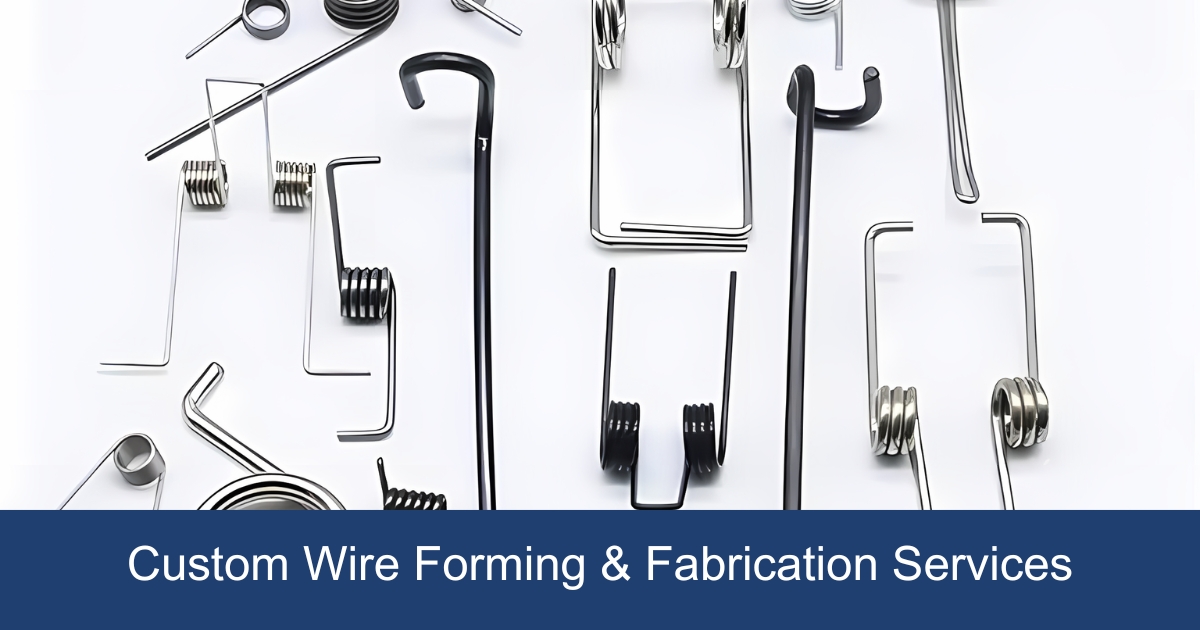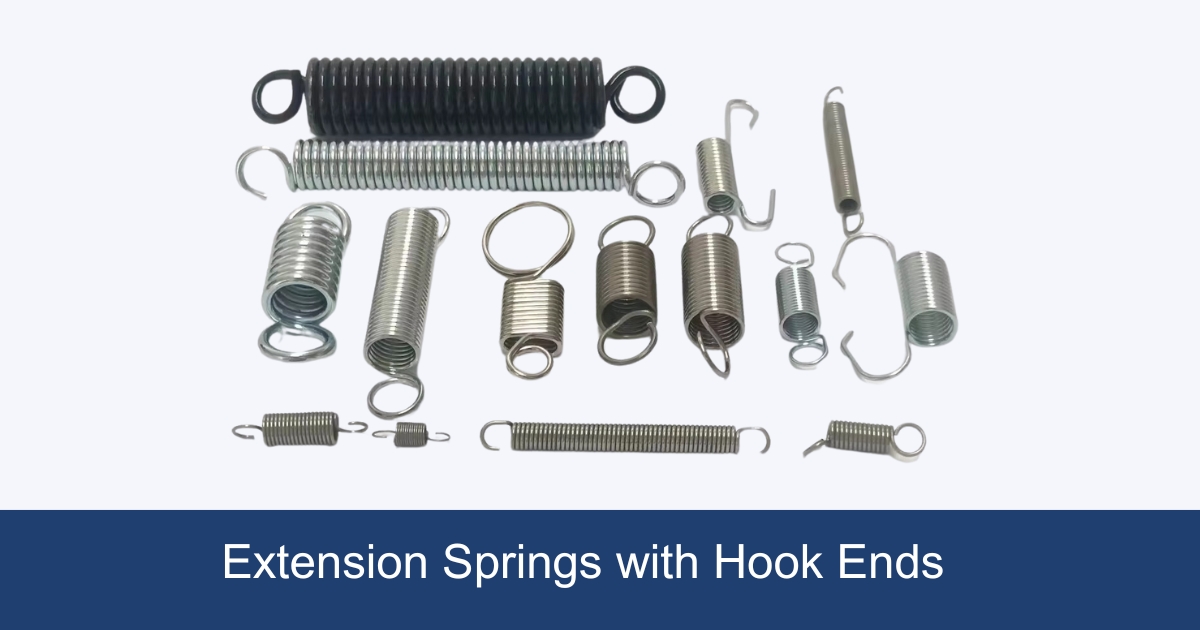Are you in need of prototyping extension springs? This journey from concept to tangible product is crucial for testing functionality and ensuring design integrity. Through this article, you’ll gain the knowledge and confidence to create prototype extension springs that not only meet but exceed expectations, ensuring the success of your projects.

7 Advantages of Prototype Extension Springs
- Customization to Meet Specific Needs: Prototype extension springs are designed to meet the exact requirements of a project, ensuring optimal performance and functionality.
- Rapid Testing and Iteration: Prototyping extension springs allows for quick testing of spring designs under real-world conditions, enabling fast iterations and improvements.
- Cost-Effective Solution: By identifying and rectifying potential issues early in the prototype extension spring design process, prototype extension springs save costs associated with large-scale production errors.
- Material and Design Flexibility: Allows for exploration of various materials and designs to find the perfect balance between strength, flexibility, and durability.
- Enhanced Performance and Reliability: Tailored to specific operational conditions, prototype springs can enhance the overall reliability and efficiency of the machinery they are part of.
- Shortened Time to Market: Accelerates the development process, enabling faster transition from design to production and market entry.
- Insightful Feedback for Final Production: Provides valuable data and insights that can be used to refine final product specifications for mass production.
Key Dimensions in Designing Extension Springs
When designing extension springs, several key dimensions and sizes are critical to ensuring the spring meets the intended performance requirements and fits within its application. Understanding these dimensions is essential for both engineers and custom extension spring manufacturers to produce springs that function as desired. Here are the most important sizes to consider:
- Wire Diameter: This is the thickness of the wire used to make the spring. The wire diameter affects the spring’s strength and flexibility. A thicker wire results in a stronger, less flexible spring, while a thinner wire offers more flexibility but less strength.
- Outer Diameter (OD): The outer diameter is the overall width of the spring, measured from the outside edges of the coils. This dimension is crucial for ensuring the spring fits within the available space in its intended application.
- Inner Diameter (ID): The inner diameter is measured from the inside edges of the coils and is important for applications where the spring needs to fit over a rod or other component.
- Free Length: This is the length of the spring when it is not under any load. The free length is important for determining how much the spring can be stretched and how it will fit into the assembly.
- Body Length: Also known as the coil length, this is the length of the coiled section of the spring. It excludes the hooks or loops at the end of the spring. The body length affects the spring’s elasticity and load capacity.
- Total Length: The total length of the spring includes the body length plus any hooks or loops. This dimension is critical for applications where the spring must reach certain points when extended.
- Spring Rate (k): While not a physical size, the spring rate is a crucial parameter in spring design. It indicates how much force is required to stretch the spring by a unit of length (e.g., pounds per inch). A higher spring rate means a stiffer spring.
- Maximum Extended Length: This is the maximum length the spring can be extended without causing plastic deformation or damage. Designing with this limit in mind ensures the spring’s longevity and performance.
- End Configurations: The size and shape of the spring’s ends (hooks, loops, etc.) are vital for how the spring will be attached or mounted in its application. The dimensions of the ends must be compatible with the other components in the assembly.
These dimensions are interrelated and must be carefully balanced to achieve the desired spring characteristics, such as load capacity, flexibility, and durability. The choice of material and manufacturing process can also influence the achievable dimensions and tolerances, further highlighting the importance of a holistic approach to extension spring design.
Additional Engineering Considerations When Prototype Extension Springs
Stress
The cornerstone of designing an extension spring lies in accurately calculating the stress it will endure. Stress impacts not only the spring’s durability but also its ability to perform consistently under varying loads. Engineers must meticulously calculate the maximum stress the spring can handle without succumbing to fatigue or failure, ensuring the design is both efficient and robust.
Load
Load considerations are paramount in spring design. The ability of a spring to absorb and store energy, then release it efficiently, defines its utility. Understanding the dynamic and static loads a spring will face is crucial in determining the wire diameter, coil count, and material type. These factors are adjusted to meet the specific force requirements, ensuring the spring’s performance aligns with its intended application.
Environmental Factors
The operating environment plays a significant role in the design of prototype extension springs. Factors such as temperature, humidity, and exposure to corrosive substances can drastically affect a spring’s performance and lifespan. Selecting materials and coatings that can withstand these conditions is essential for creating a durable and reliable prototype extension spring.
Materials
Material selection is critical in spring design. High-grade spring steel is commonly used for its excellent tensile strength and fatigue resistance. However, applications requiring resistance to corrosion or non-magnetic properties might leverage stainless steel, Inconel, or even titanium. Each material offers unique benefits and challenges, underscoring the importance of aligning material properties with application needs.
Tolerances
Tolerances dictate the permissible deviation from the specified dimensions and are a key factor in the quality and performance of prototype extension spring. Tight tolerances ensure consistent performance but may increase manufacturing complexity and cost. Balancing precision with practicality is a critical aspect of spring design.
Material selection for prototype extension springs
The journey from conceptualizing to creating a functional prototype extension spring hinges significantly on selecting the right material. This choice impacts not only the spring’s performance but also its durability, cost, and suitability for specific industries. In this chapter, we delve into various extension spring materials, discussing their grades, properties, advantages, disadvantages, and the industries best suited for each.
1. High-Carbon Steel (Grade ASTM A228)
- Properties: High tensile strength, good shock absorption.
- Advantages: Cost-effective, strong, and durable, making it suitable for heavy-duty applications.
- Disadvantages: Prone to corrosion if not properly coated or maintained.
- Suitable Industries: Automotive, construction, and agriculture for its robustness in handling high stresses.
2. Stainless Steel (Grades 302, 304, 316)
- Properties: Excellent corrosion resistance, good strength-to-weight ratio.
- Advantages: Ideal for corrosive environments; does not require additional surface treatments.
- Disadvantages: More expensive than high-carbon steel and can be harder to work with due to its strength.
- Suitable Industries: Marine, medical devices, and food processing, where corrosion resistance is paramount.
3. Phosphor Bronze (Grade ASTM B159)
- Properties: Good electrical conductivity, excellent fatigue resistance, and corrosion resistance.
- Advantages: Maintains performance in varying temperatures and electrical applications.
- Disadvantages: Higher cost compared to some steels and lesser tensile strength.
- Suitable Industries: Electrical, electronics, and aerospace for its non-magnetic properties and electrical conductivity.
4. Inconel Alloy (Grades 600, 718)
- Properties: High temperature and corrosion resistance, good strength under thermal stress.
- Advantages: Performs well in extreme environments, maintaining strength at high temperatures.
- Disadvantages: Very high cost and difficult to manufacture due to its hardness.
- Suitable Industries: Aerospace, nuclear, and chemical processing where the extension springs are exposed to high temperatures and corrosive substances.
5. Titanium (Grades 5, 23)
- Properties: High strength-to-weight ratio, excellent corrosion resistance, and biocompatibility.
- Advantages: Lightweight and strong, suitable for reducing overall product weight while maintaining durability.
- Disadvantages: High material and processing costs.
- Suitable Industries: Biomedical, aerospace, and automotive for lightweight and high-strength requirements.
Considerations for Material Selection When Prototype Extension Spring
When selecting a material for prototype extension springs, several factors must be considered:
- Application Requirements: Understand the mechanical stresses, environmental conditions, and life expectancy of the spring in its intended application.
- Cost-Efficiency: Balance the material properties needed with the budget constraints, considering both material costs and manufacturing complexities.
- Industry Standards: Comply with industry-specific regulations and standards, especially in sectors like medical, food processing, and aerospace.
Finishes selection for prototype extension springs
The selection of finishes for prototype extension springs is a critical component of the design process, affecting not only the aesthetic appeal but more importantly, the functional performance and longevity of the spring under various operational conditions. This chapter explores the various prototype extension springs finishing options available, detailing their properties, advantages, disadvantages, and the applications for which they are best suited.
1. Electroplating
Subtypes:
- Nickel Plating: Provides a hard surface with moderate corrosion resistance.
- Zinc Plating: Offers excellent corrosion resistance at a lower cost, commonly used with a chromate conversion coating for added protection.
Properties: Enhances surface hardness, corrosion resistance, and aesthetic appeal.
Advantages: Cost-effective method to increase prototype extension springs corrosion resistance; can also enhance appearance.
Disadvantages: The plating process involves chemicals that may be harmful to the environment; thinner coatings may wear off over time, reducing effectiveness.
Ideal Applications: Suitable for applications requiring moderate extension springscorrosion resistance and an attractive finish, such as automotive and consumer electronics.
2. Passivation
Subtypes:
Stainless Steel Passivation: Involves treating stainless steel with a mild oxidant to remove free iron from the surface and enhance the natural chromium oxide layer.
Properties: Increases corrosion resistance by enhancing the natural oxide layer.
Advantages: Improves extension spring corrosion resistance without changing the spring’s dimensions; environmentally friendly process.
Disadvantages: Effectiveness depends on the alloy and environmental conditions; not suitable for all types of stainless steel.
Ideal Applications: Critical for stainless steel springs used in medical devices and food processing, where maximum extension springs corrosion resistance is essential.
3. Powder Coating
Properties: Offers a thick, durable layer of protection that is more resistant to chipping, scratching, and corrosion than many other finishes.
Advantages: Available in a wide range of colors, environmentally friendly, and provides a uniform finish without sagging or running.
Disadvantages: The coating can be too thick for very small or intricate springs, potentially affecting the spring’s function.
Ideal Applications: Ideal for springs that require a durable finish with specific color requirements, such as consumer goods and automotive parts.
4. Black Oxide
Properties: Provides a thin, black layer on the surface of the prototype extension spring, offering minimal dimensional changes.
Advantages: Enhances corrosion resistance slightly, reduces light reflection, and improves lubrication adherence.
Disadvantages: Offers less corrosion resistance than other finishes; usually requires additional oil or wax coating for protection.
Ideal Applications: Used where a non-reflective surface is required, such as in military and firearms applications.
5. Anodizing (For Aluminum Springs)
Properties: Converts the spring surface into a durable, corrosion-resistant, anodic oxide finish.
Advantages: Hard, durable surface; enhanced corrosion and wear resistance; can be dyed in various colors.
Disadvantages: Applicable only to aluminum and its alloys; the process increases surface roughness.
Ideal Applications: Suitable for aluminum springs used in aerospace, automotive, and consumer electronics where durability and color customization are desired.
Selecting the appropriate finish for prototype extension springs is a nuanced decision that requires a thorough understanding of the spring’s material, intended use, and operational environment. By carefully considering the properties and applications of each finishing option, designers and custom extension spring Manufacturers can ensure their prototype springs are not only visually appealing but also optimized for performance, durability, and environmental compatibility.
Manufacturing Prototype Extension Springs Process
The process of manufacturing prototype extension springs involves several key steps, each critical to ensuring the final product meets the required specifications and performance criteria. This chapter outlines the stages involved in transforming a spring design from a concept into a tangible prototype, highlighting the importance of precision, quality control, and collaboration throughout the extension spring manufacturing process.
1. Design Review and Finalization
The first step in manufacturing prototype extension springs is a thorough review of the spring design. This involves ensuring that all specifications, including dimensions, material selection, and finish requirements, are accurately documented and feasible for extension spring manufacturing. Any potential issues are addressed at this stage, often requiring close collaboration between the design engineers and extension spring factory to finalize the design for production.
2. Material Preparation
Once the design is finalized, the selected material for the spring is prepared. This includes cutting the spring wire to the required length and ensuring the wire is free of defects. Material quality is paramount, as any imperfections can significantly impact the spring’s performance.
3. Spring Coiling
The core of the manufacturing process is coiling the spring wire into the desired shape. This is typically done using CNC coiling machines for precision and consistency. The machine settings are adjusted based on the spring design, including coil diameter, pitch, and the number of coils, to accurately produce the prototype according to the specifications.
4. Heat Treatment
After coiling, the springs undergo heat treatment to relieve stress and enhance their mechanical properties, such as tensile strength and elasticity. The specific heat treatment process and parameters depend on the material used and the required properties of the finished spring.
5. Finishing
Following heat treatment, the springs are finished according to the design specifications. This may include applying protective coatings or platings, such as zinc or nickel, for corrosion resistance, or passivation for stainless steel springs to enhance their corrosion resistance further. The finishing process plays a crucial role in the spring’s longevity and performance, especially in challenging environmental conditions.
6. Quality Control and Testing
Quality control is an integral part of the prototype extension spring manufacturing process, with rigorous testing performed on the prototype springs to ensure they meet all design specifications and performance criteria. This includes load testing, fatigue testing, and dimensional checks, among others. The results from these tests may lead to further refinements in the manufacturing process to achieve the desired spring properties.
7. Final Inspection and Approval
The last step in the manufacturing process is a comprehensive final inspection of the prototype springs. This includes a review of all test results and a final physical inspection to ensure the prototypes are free from defects and ready for real-world application testing or integration into the final product.
Conclusion
As we’ve explored the world of prototype extension springs, it’s clear that their development is not just about metal and measurements—it’s about bringing visions to life. For those in the industry, the challenge is to push the boundaries of what’s possible, to innovate and refine. Whether you’re at the helm of a project requiring custom tension springs or seeking the expertise of a mechanical tension spring factory, the path forward is collaboration.
Engage with Zigoal, an prototype extension spring manufacturer China who understands your vision and possesses the capability to turn your concepts into operational successes. Let’s innovate together, crafting solutions that not only meet but exceed the demands of tomorrow.



